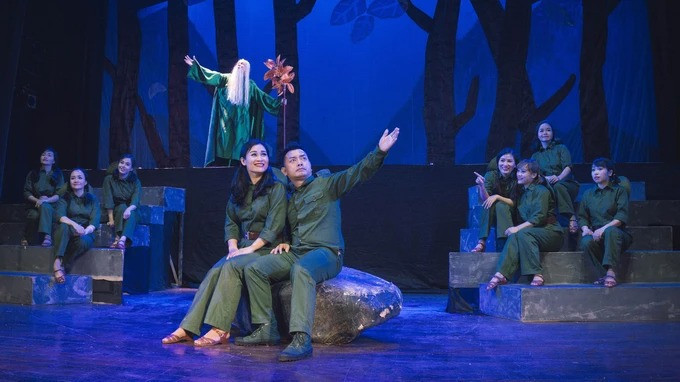
‘Co Sao’, composed by Do Nhuan and officially recognized as the first Vietnamese opera, was first performed in 1965, with more than 150 musicians and actors.
In 2011, ‘La do’ (Red Leaf), composed by Do Hong Quan to the order of the Ministry of Culture, Sports and Tourism (MCST), was performed at the Hanoi Opera House. It was highly praised by experts and audiences.
In recent years, a number of musical projects have attracted the attention of audiences, such as the HOPE project by young director Nguyen Phi Phi Anh with three operas, ‘Goc pho danh vong’ (Corner of Fame), ‘Dem he sau cuoi’ (Last Night after the Summer) and ‘Mong uoc khong xa voi’ (The Plausible Dream), performed 35 consecutive times.
Les Miserables, staged by the Vietnam Opera and Ballet Theater based on the novel of the great French writer V. Hugo, sold out its many shows at the theater.
Not only plays with foreign scripts, many Vietnamese art units have tried purely Vietnamese musicals, such as ‘De men phieu luu ky’ (Diary of a Cricket) by the HCM City Ballet Symphony Orchestra and Opera; ‘Tien Nga’ (Fairy Tale) by IDEACF Stage; 'Hanoi xua va nay’ (Hanoi: Past and Present) and ‘Toi doc bao sang nay’ (I Read Newspaper This Morning) by Thang Long Music and Dance Theater; ‘Trai hoa vang’ (Golden Flower Farm), ‘Song’ (Waves) and ‘Bua tiec cua Elsa’ (Elsa's Party) by the Youth Theater, and ‘Nguoi cam lai’ (The Helmsman) by the People's Public Security Theater.
Most recently, the Hai Phong Song and Dance Troupe performed Bi Vo, a musical with a historical theme, receiving enthusiastic responses from audiences and experts.
Famous musician Do Hong Quan said music is the best means of conveying emotions to the audience.
He noted that in the 1960s, the country had a purely Vietnamese opera, which followed an international model with classic features, called Co Sao. Later, this was modified, and the musical theater movement began with plays consisting of singing, dancing, speaking and interactions. The plays are more simple in terms of actors, performances and orchestra.
With these modifications, Vietnamese artists adopted both domestic and international features that are more easily accessible to audiences.
“We applaud the use of historical and revolutionary themes as materials for operas. It is necessary to use musical language and artistic force to convey ideas. This will balance artistic creativity and historical value,” Quan said.
According to musician Luu Quang Minh, Broadway in New York City is located on an ordinary city street but its majestic and splendid theaters have large spaces and impressive architecture, with impressive sound and lighting systems. In South Korea, musicals are performed regularly and attended by both locals and tourists.
“If Vietnam can compose programs with specific characteristics, it can absolutely attract tourists,” Minh said.
Musician Tran Le Chien believes that, in addition to traditional musicals, Vietnam can create new art forms such as modern operas and operas based on literary plots, fairy tales and ancient stories as well as new compositions. The diversity of musicals can bring new fresh air to the stage.
However, Chien said that Vietnam will have to follow a long path to reach that end, because of certain difficulties. Cao Ngoc Anh, deputy director of the Youth Theater, agreed, saying that musicals need artists fluent in singing, acting and dancing, but very few Vietnamese artists have all three skills.
Tinh Le